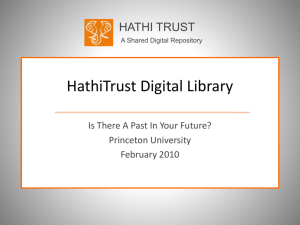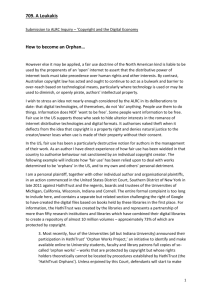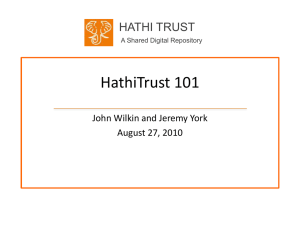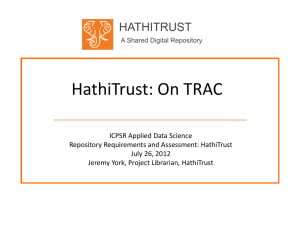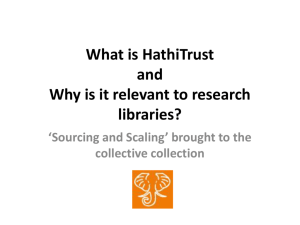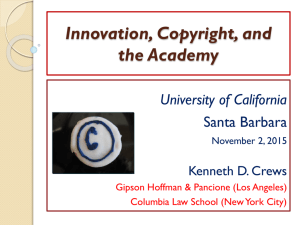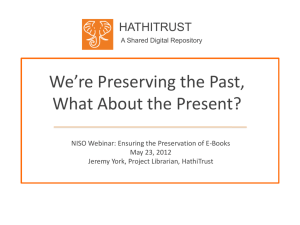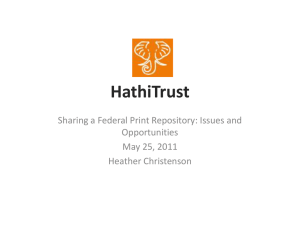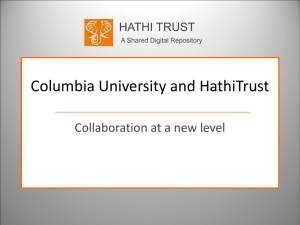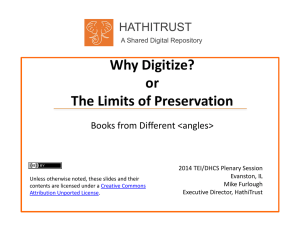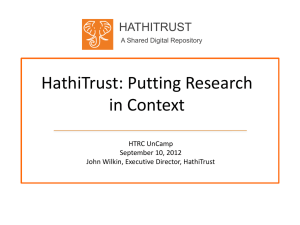Business Models for the Interdependent Digital Collection
advertisement
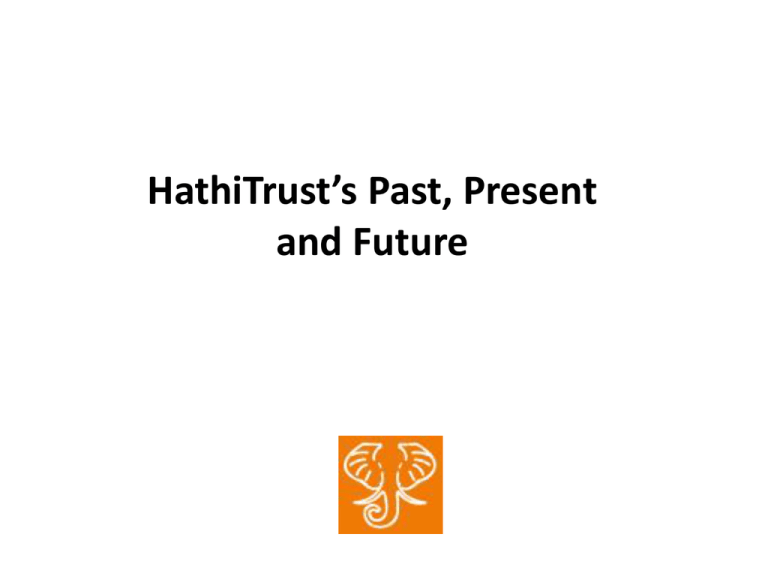
HathiTrust’s Past, Present and Future Short- and Long-term Functional Objectives Short-term • Page turner mechanism (and Mobile!) • Branding (overall initiative; individual libraries) • Format validation, migration and error-checking • Development of APIs that will allow partner libraries to access information and integrate it into local systems individually • Access mechanisms for persons with disabilities • Public ‘Discovery’ Interface for HathiTrust • Ability to publish virtual collections • Mechanism for direct ingest of non-Google content Long-term • Compliance with required elements in the Trustworthy Repositories Audit and Certification (TRAC) criteria and checklist • Robust discovery mechanisms like full-text cross-repository searching • Development of an open service definition to make it possible for partner libraries to develop other secure access mechanisms and discovery tools • Support for formats beyond books and journals • Development of data mining tools for HathiTrust and use by HathiTrust of other analysis tools from other sources mobile Short- and Long-term Functional Objectives Short-term • Page turner mechanism • Branding (overall initiative; individual libraries) • Format validation, migration and error-checking • Development of APIs that will allow partner libraries to access information and integrate it into local systems individually • Access mechanisms for persons with disabilities • Public ‘Discovery’ Interface for HathiTrust • Ability to publish virtual collections • Mechanism for direct ingest of non-Google content Long-term • Compliance with required elements in the Trustworthy Repositories Audit and Certification (TRAC) criteria and checklist • Robust discovery mechanisms like full-text cross-repository searching • Development of an open service definition to make it possible for partner libraries to develop other secure access mechanisms and discovery tools • Support for formats beyond books and journals • Development of data mining tools for HathiTrust and use by HathiTrust of other analysis tools from other sources Governance Budget, Finances Decision-making Policy Enterprise Management Repository Administration Repository Administration Communication and Coordination with partner institutions Hardware configuration and maintenance Data management (content storage, backup, integrity checks, deletion) Project management Planning Web and application server configuration and maintenance Security Hardware selection and replacement Content and Metadata specifications Permissions Rights Management Bibliographic Data Management Copyright determination Entity description (record-level) Copyright review Object identification (item-level) Copyright information management (database) Data availability Collection Development Digital • Expansion beyond books and journals (born-digital, images and maps, audio) • Selection of content (for nonGoogle volume ingest and pilots projects) Print • Cloud Library (effect of digital on print) Rightsholder permissions Disaster Recovery Logging Processes for ensuring content integrity e-Commerce Print on Demand Content Ingest Content Access Quality Assurance User Services Transformation PageTurner Quality Review Usability Validation Collection Builder Content Certification User support (helpdesk) Large-scale Search Financial contributions of partners Research Center Bibliographic Catalog APIs HathiTrust Functional Framework Outreach Project website Monthly newsletter Papers and presentations Communication with potential partners Surveys, general inquiries Repository evaluation and audit (e.g., DRAMBORA, TRAC) Legal Risk management (use of materials) Partner agreements Advocacy A global change in the library environment 60% Academic print book collection already substantially duplicated in mass digitized book corpus 50% % of Titles in Local Collection June 2010 Median duplication: 31% 40% 30% 20% June 2009 Median duplication: 19% 10% 0% 0 20 40 60 80 Rank in 2008 ARL Investment Index 100 120 A global change in the library environment 60% Academic print book collection already substantially duplicated in mass digitized book corpus 50% % of Titles in Local Collection June 2010 Median duplication: 31% 40% 30% 20% June 2009 Median duplication: 19% 10% 0% 0 20 40 60 80 Rank in 2008 ARL Investment Index 100 120 For public domain volumes: (PD*X*C)/N For a given incopyright volume: IC=(C*X)/H Public Domain Cost PD * X *C PublicDomainCost = = $10,332.31 N PD = PublicDomainWorks = 2, 620, 054 X = SurplusModifier = 1.5 C = AveCostPerVolume = $0.163 N = NumberOfMembers = 62 IC Single-part Monographs $80,000.00 $70,000.00 $60,000.00 Cost (USD) $50,000.00 $40,000.00 $30,000.00 $20,000.00 $10,000.00 $0.00 1 3 5 7 9 11 13 15 17 19 21 23 25 27 29 31 33 35 37 39 41 43 45 47 49 51 53 55 57 59 61 Member IC Serials $160,000.00 $140,000.00 $120,000.00 Cost (USD) $100,000.00 $80,000.00 $60,000.00 $40,000.00 $20,000.00 $0.00 1 3 5 7 9 11 13 15 17 19 21 23 25 27 29 31 33 35 37 39 41 43 45 47 49 51 53 55 57 59 61 Member All Costs $250,000.00 Cost (USD) $200,000.00 $150,000.00 mono serial $100,000.00 PD $50,000.00 $0.00 1 3 5 7 9 11 13 15 17 19 21 23 25 27 29 31 33 35 37 39 41 43 45 47 49 51 53 55 57 59 61 Member A “surprise” 1m volumes PD * X *C PublicDomainCost = = $3,943.55 N PD = PublicDomainWorks = 1000000 X = SurplusModifier = 1.5 C = AveCostPerVolume = $0.163 N = NumberOfMembers = 62 Publisher Relations and Publishing • Making it possible for rights holders to open access to works • Making it possible for publishers to deposit digital masters for archiving (and open access) • Making it possible to publish directly into HathiTrust Uses of in-copyright materials • • • • Services for users with print disabilities Section 108-related work Orphan works … and of course other cases with permission of the rights holder HathiTrust Content Growth Changing the way we work • Pooling resources to solve a common problem once • Applying resources from our individual institutions to collectively attack a common problem • Coordinated and collective action (e.g., best practices) Thank you!
